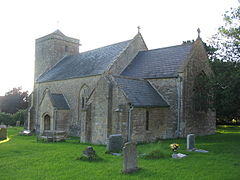Lamyatt

| Lamyatt | |
|---|---|
 | |
Location within Somerset | |
| Population | 183 (2011)[1] |
| OS grid reference | ST656356 |
| Civil parish |
|
| Unitary authority | |
| Ceremonial county | |
| Region | |
| Country | England |
| Sovereign state | United Kingdom |
| Post town | SHEPTON MALLET |
| Postcode district | BA4 |
| Dialling code | 01749 |
| Police | Avon and Somerset |
| Fire | Devon and Somerset |
| Ambulance | South Western |
| UK Parliament | |
Lamyatt is a village and civil parish in the Mendip district of Somerset, England. It lies 5 miles (8 km) south east of Shepton Mallet, 2 miles (3 km) north east of Castle Cary, and 3 miles (5 km) south of Evercreech. The parish has a population of 183.[1]
History
[edit]A square, Roman-period Celtic temple built in the late 3rd century, is situated a mile north-west of the parish on the summit of Lamyatt Beacon. It fell into disuse at the end of the Roman period and a small east-west building was constructed nearby. A small cemetery was radiocarbon dated to the early middle ages.[2]
Lamyatt was recorded in the Domesday book as Lamieta meaning "the lamb's gate" from the Old English lamb and goat. The Abbot of Glastonbury Abbey owned the land and 5 hides (660 acres) were sublet to Nigel the Doctor.[3]
The parish of Lamyatt was part of the Whitstone Hundred.[4]
Governance
[edit]The parish council has responsibility for local issues, including setting an annual precept (local rate) to cover the council’s operating costs and producing annual accounts for public scrutiny. The parish council evaluates local planning applications and works with the local police, district council officers, and neighbourhood watch groups on matters of crime, security, and traffic. The parish council's role also includes initiating projects for the maintenance and repair of parish facilities, as well as consulting with the district council on the maintenance, repair, and improvement of highways, drainage, footpaths, public transport, and street cleaning. Conservation matters (including trees and listed buildings) and environmental issues are also the responsibility of the council.
The village falls within the Non-metropolitan district of Mendip, which was formed on 1 April 1974 under the Local Government Act 1972, having previously been part of Shepton Mallet Rural District,[5] which is responsible for local planning and building control, local roads, council housing, environmental health, markets and fairs, refuse collection and recycling, cemeteries and crematoria, leisure services, parks, and tourism.
Somerset County Council is responsible for running the largest and most expensive local services such as education, social services, libraries, main roads, public transport, policing and fire services, trading standards, waste disposal and strategic planning.
It is also part of the Frome and East Somerset county constituency represented in the House of Commons of the Parliament of the United Kingdom. It elects one Member of Parliament (MP) by the first past the post system of election, and was part of the South West England constituency of the European Parliament prior to Britain leaving the European Union in January 2020, which elected seven MEPs using the d'Hondt method of party-list proportional representation.
Religious sites
[edit]St Mary and St John Church dates from the 13th century, and has been designated by English Heritage as a grade II* listed building.[6]
Notable people
[edit]- John Copleston (1841–1918), cricketer and clergyman
References
[edit]- ^ a b "Lamyat Parish". Neighbourhood Statistics. Office for National Statistics. Retrieved 1 January 2014.
- ^ Leech, Roger (1986). "The Excavation of a Romano-Celtic Temple and a later Cemetery on Lamyatt Beacon, Somerset". Britannia. 17: 259–328. doi:10.2307/526548. JSTOR 526548. S2CID 162931828.
- ^ Robinson, Stephen (1992). Somerset Place Names. Dovecote Press. ISBN 1-874336-03-2.
- ^ "Somerset Hundreds". GENUKI. Retrieved 22 October 2011.
- ^ "Shepton Mallet RD". A vision of Britain Through Time. University of Portsmouth. Retrieved 4 January 2014.
- ^ Historic England. "Church of St Mary and St John (1344874)". National Heritage List for England. Retrieved 30 October 2007.

